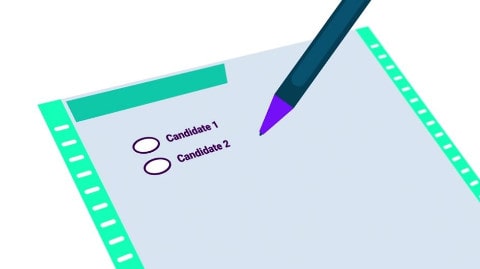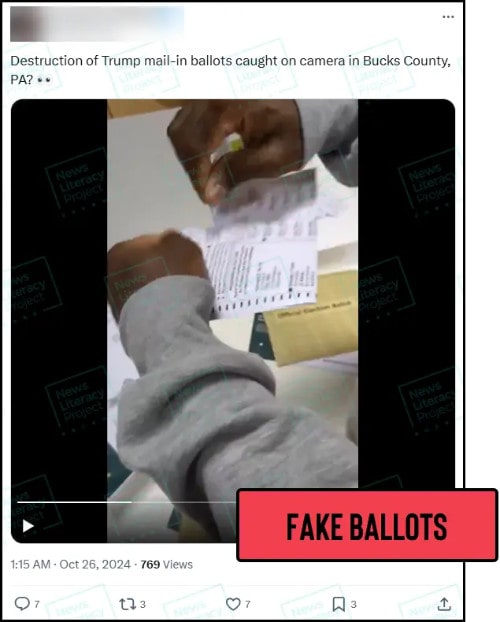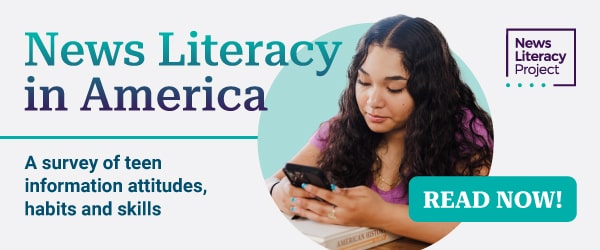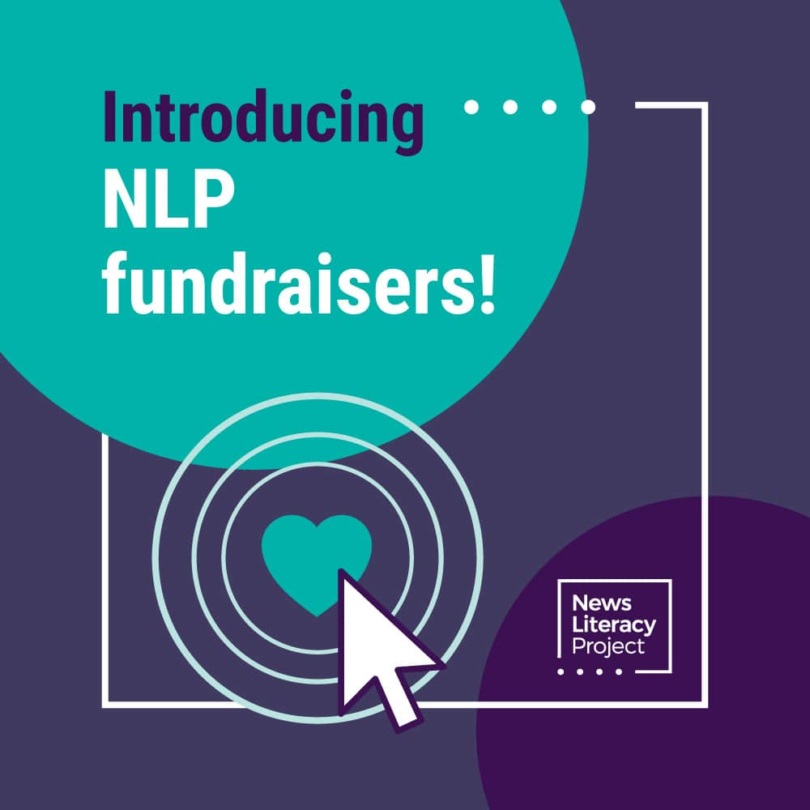| Note: There is no Get Smart About News issue next week following Veterans Day. This newsletter will return on Nov. 19. |
In this issue
Election rumors | X content moderation
Top picks
{{Salutation or 'Reader'}}, this section highlights the latest news literacy topics and ways for you to engage with the kids in your life.

| There are several reasons why newspapers may or may not endorse presidential candidates. Illustration credit: The News Literacy Project. |
1. Newspapers shift away from endorsements
Newspapers choose not to endorse a presidential candidate for a variety of reasons, and for some it’s nothing new. Papers that have discontinued the practice have chalked it up to tight budgets, staff shortages, not wanting to tell readers what to think, a preference for focusing exclusively on local candidates, or a desire to end the confusion many people have over the distinction between editorial boards and newsrooms, according to media analyst Rick Edmonds. The Wall Street Journal, for example, hasn’t endorsed a presidential candidate in nearly a century. And the country’s largest newspaper chain, Gannett, decided last year that its 200 publications wouldn’t endorse a presidential candidate this year, instead focusing on local races.
While some news outlets make principled decisions against political endorsements, recent decisions at The Washington Post and Los Angeles Times not to endorse a presidential candidate sparked widespread outrage. The papers’ owners both blocked endorsements less than two weeks ahead of the election — leading to resignations and allegations that editorial independence had been compromised. In a column defending the decision, Washington Post owner Jeff Bezos argued that presidential endorsements “create a perception of bias.” Washington Post reporters, independent from the paper’s editorial board and owner, have rigorously covered the blocked endorsement in news articles and even a TikTok video.
| Engage: |
Is your teen on Instagram? Share this post or NBC News video with them about the role of an editorial board and how it operates independently from the newsroom at standards-based publications. Discuss the impact of newspaper endorsements. Why are some readers frustrated with The Washington Post and Los Angeles Times decision? Why do some newspapers quit issuing political endorsements?
| Related: |
- “Newspaper non-endorsements at Washington Post, LA Times fit a trend, but their readers aren’t happy” (David Bauder, The Associated Press).
- “LA Times union begs readers not to cancel the subscriptions that pay their salaries after blasting owner” (Alexander Hall, Fox News).
★ Tools for the talk:


Infographic: “In brief: News media bias”


Quiz: “How newsrooms work”
2. Viral election misinfo boosted on X
Content moderation on X isn’t effectively weeding out election misinformation through Community Notes, its crowd-sourcing feature, according to a new report from the Center for Countering Digital Hate. About 74% of accurate Community Notes for misleading posts weren’t being shown to X users, or 209 out of 283 posts sampled in the report.
The social media platform has also introduced incentives to post sensational false claims and conspiracies: X now pays Premium X users based on engagement. In a recent investigation, BBC interviewed X users who are doing this — including one who makes thousands a month sharing AI-generated political memes and images.
X owner Elon Musk has also shared election misinformation on the platform to more than 200 million followers, creating what one election official called a “huge problem” in battleground states that are outmatched by X’s algorithm.
| Engage: |
X is not as popular for kids as platforms like TikTok, YouTube and Instagram. Even if they’re not using X, chat with them about this topic. If they were in charge of a tech company, what rules would they have in place to moderate content? What role do algorithms play in determining the information we see on social media? What is the impact of election misinformation on American democracy?
| Related: |
- “An Elon Musk-backed political group is posting fake Kamala Harris ads on Facebook” (Bobby Allyn, NPR).
- “Georgia official demands Elon Musk take down fake migrant voting video” (Justin Glawe and Andrew Perez, Rolling Stone).
| Note: False claims about election integrity — such as destroyed ballots, illegal voters and voting machines flipping votes — spiked in the days leading up to the election. Prepare for election night by reading this new NLP blog post, which has helpful tips to counter misinformation and links to a guide with five election disinformation trends to watch for. |
★ Tool for the talk:


Infographic: “6 things to know about AI”
3. Should the crime beat be abolished?
During the racial justice movement of 2020, two Pennsylvania journalists predicted that the crime beat would — or should — be abolished. The emphasis on crime in news, they wrote, was classist and racist, made people feel less safe, and didn’t serve the public. Four years later, the crime beat is still around in most newsrooms but there have been gradual changes, such as limiting the use of mug shots and redeveloping the beat to focus on public safety. However, some say their local news outlets need to be accountable for past or current harm in crime news coverage — and transform it so it better serves communities.
| Engage: |
Have a conversation with your teen about this topic. If they were a newsroom leader, what kind of local public safety issues would they cover?
| Related: |
- “The Star usually does not publish mugshots. But there are exceptions — and this is one” (Mará Rose Williams, The Kansas City Star).
- “Local news covers a lot of crime, yet people can’t find the crime news they need” (Kelly McBride, Poynter).
- “Black Americans’ mistrust of the U.S. news media” (Kiana Cox, Pew Research Center).


Viral video falsely claims to show Trump votes being destroyed


❌ NO: This video does not show someone destroying genuine ballots for the 2024 presidential election with votes for former President Donald Trump in Bucks County, Pennsylvania.
✅ YES: The Bucks County Board of Elections and the Bucks County Republican Committee both released statements confirming the video is fake and the ballots are not authentic.
★ NewsLit takeaway
The News Literacy Project’s Misinformation Dashboard: Election 2024 is seeing a sharp uptick in false claims related to election integrity. Here are some things to keep in mind:
- Approach online claims about politics with skepticism.
- Practice patience while scrolling on social media, as misinformation travels faster than facts.
- Consider if the source of a claim is trustworthy.
A media forensics expert told the global news agency AFP that the video was likely created by a Russian propaganda group aiming to undermine confidence in elections in the United States. Social media users can expect to see similarly deceptive claims in the days ahead. When in doubt, check claims against standards-based news outlets and local election officials.
No, states aren’t cheating if they don’t have results on election night
![A Thread post reads, “BREAKING [red alarm] The Cheat Has Begun. The States of Michigan, Georgia, and Pennsylvania have officially announced that they will
not have election results available on Election Night.” The News Literacy Project has added a label that says “MISSING CONTEXT.”](https://newslit.org/wp-content/uploads/2024/11/rg2-nov4-24-min-1.jpg)
![A Thread post reads, “BREAKING [red alarm] The Cheat Has Begun. The States of Michigan, Georgia, and Pennsylvania have officially announced that they will
not have election results available on Election Night.” The News Literacy Project has added a label that says “MISSING CONTEXT.”](https://newslit.org/wp-content/uploads/2024/11/rg2-nov4-24-min-1.jpg)
✅ YES: Election officials in Michigan, Georgia and Pennsylvania say they don’t expect to be finished tallying and certifying votes by election night on Nov. 5.
❌ NO: A delay in certifying the results is not evidence of election fraud.
✅ YES: Some key swing states prohibit processing mail and absentee ballots until Election Day and others expect to report results in the days after due to high turnout or other reasons.
★ NewsLit takeaway
Misinformation about the election process spreads online to create doubts about the credibility of the results. Keep these points in mind:
- A winner may not be confirmed on election night, especially if the race is close. This is common and not evidence of voter fraud.
- Learning about the election process can safeguard against election misinformation.
- Pause and think critically about the source of a viral claim before sharing it.
False claims often target gaps in our knowledge. This viral claim, for example, is built on a common misconception about the vote counting process, suggesting that a normal delay is something more sinister.


| What exactly are journalists so busy doing on Election Day? Here’s a peek at how The New York Times and The Associated Press cover the results. | |
| Press freedom conditions in four major swing states — Arizona, Florida, Nevada and Pennsylvania — show major shortcomings like hostility to media and lack of economic viability of news outlets, according to a new Reporters Without Borders report. Most journalists surveyed (94%) said that public records requests were stalled or ignored. | |
| Two journalists in Mexico were shot and killed in separate attacks, within a day of each other. The U.N. office of human rights said at least five journalists have been killed in Mexico this year. | |
| Spanish-language misinformation is less likely to be corrected than falsehoods in English and tends to survive longer in apps popular among Latinos, such as YouTube and WhatsApp. Experts say culturally appropriate solutions, like understanding Venezuelans’ apprehension of government, must be considered when countering misinformation. | |
| Political polarization doesn’t just affect our political views — it also causes mental and physical health issues. | |
| Hundreds were ghosted at a Halloween parade in Dublin after seeing an AI-generated list of local events on a website. The disappointed crowds lined the streets, but no parade came. | |
| Got decision fatigue? Generative AI could be the answer … or not. In a weeklong experiment, a New York Times writer allowed AI to make all decisions for her: haircut, paint colors, grocery shopping. The results were mixed. | |
| NBC has been accused of violating the Federal Communications Commission’s rule on giving competing candidates equal time after Vice President Kamala Harris appeared on Saturday Night Live over the weekend. | |
| TikTok’s algorithm appears to be steering female users toward content about Harris, while simultaneously steering men toward videos about former President Donald Trump, according to an experiment by The Washington Post. | |
| More than 60 student journalists at Howard University in Washington, D.C., will be involved in covering Election Day news. Harris is an alumna of the historically Black university and plans to be there for election night. |
Thanks for reading!
Your weekly issue of Get Smart About News is created by Susan Minichiello (@susanmini), Dan Evon (@danieljevon), Peter Adams (@PeterD_Adams), Hannah Covington (@HannahCov) and Pamela Brunskill (@PamelaBrunskill). It is edited by Mary Kane (@marykkane) and Lourdes Venard (@lourdesvenard).




